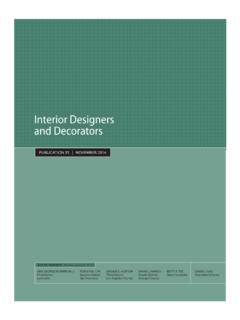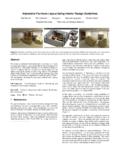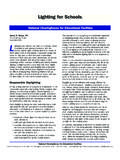Transcription of Technical Information - Guardian Industries
1 Technical InformationWhat you need to know toBUILD WITH LIGHT InTroDUcTIon _____1 Types of GLass _____ 2annealed Glass Heat-strengthened Glass Tempered Glass Laminated Glass Insulating Glass Warm-edge spacer Tinted Glass vs. Low-e coated Glass spandrel Glass common Glass configurations Hurricane Glass Bird-friendly Glass Turtle Glass performance cHaracTerIsTIcs of GLass _____ 7 energy conservation and coated GlasssunGuard advanced architectural GlassGlass performance: spectral Graphs acoustical Information How to View/evaluate Glass Hand samples faBrIcaTIon anD GLazInG _____ 17 optical Distortion Thermal Breakage construction-phase risks of Thermal Breakagestatistical probability of Glass BreakageHeat-soakingWind Load Bending sunGuard coated Glass strain pattern moir pattern Glass edge Types Glass Handling, storage, maintenance and cleaning coated Glass: minimum & maximum sizes oversize Glass.
2 Insulating and Heat-treatment considerations Glazing GuidelinesQuality/Inspection Guidelines oTHer resoUrces _____ 26architectural Tools standards Used in architectural Glass Warranty GLossary of Terms _____ 28architectural GlassIntroductionarchitects, designers and builders have more choices of glass today than ever before. Those choices can make a tremendous difference in your project s cost, energy efficiency and environmental impact. so you need accurate, detailed Information to ensure that you choose the right brochure provides Technical Information including performance capabilities and glazing guidelines for all types of sunGuard advanced architectural Glass from Guardian . It also contains instructions for the proper handling, maintenance and cleaning of the glass before, during and after building construction. We believe that you ll find most of the answers you need in this brochure, but you re always welcome to call us at 1-866-GuardsG (482-7374) to consult with a sunGuard advanced architectural Glass specialist or to order a glass : Ben BenschneiderTypes of GlassGetting the right type of glass or the right combination of types can be critical to the success of your project.
3 This section defines the various kinds of glass, how they re made, and their strengths and characteristics. It also diagrams construction techniques to show how different glass types can be combined for the desired heat, light and insulation properties. anneaLeD GLassfloat glass (also called flat glass) that has not been heat-strengthened or tempered is annealed glass. annealing float glass is the process of controlled cooling to prevent residual stress in the glass and is an inherent operation of the float glass manufacturing process. annealed glass can be cut, machined, drilled, edged and GLassHeat-strengthened (Hs) glass has been subjected to a heating and cooling cycle and is generally twice as strong as annealed glass of the same thickness and configuration. Hs glass must achieve residual surface compression between 3,500 and 7,500 psI for 6mm glass, according to asTm c 1048.
4 Please contact Guardian regarding thicker glass standards. Hs glass has greater resistance to thermal loads than annealed glass and, when broken, the fragments are typically larger than those of fully tempered glass and initially may remain in the glazing opening. Heat-strengthened glass is not a safety glass product as defined by the various code organizations. This type of glass is intended for general glazing, where additional strength is desired to withstand wind load and thermal stress. It does not require the strength of fully tempered glass, and is intended for applications that do not specifically require a safety glass product. When heat-treated glass is necessary, Guardian Glass recommends the use of heat-strengthened glass for applications that do not specifically require a safety glass product. Hs glass cannot be cut or drilled after heat-strengthening and any alterations, such as edge-grinding, sandblasting or acid-etching, can cause premature failure.
5 TempereD GLassfully tempered glass is approximately four times stronger than annealed glass of the same thickness and configuration, and residual surface compression must be over 10,000 psI for 6mm, according to asTm c 1048. please contact Guardian for thicker glass standards. When broken, it will break into many relatively small fragments, which are less likely to cause serious injury. The typical process to produce tempered glass involves heating the glass to over 1,000 degrees f, then rapidly cooling to lock the glass surfaces in a state of compression and the core in a state of tension as shown in the diagram. 2 CompressionTensionGlassThickness(t = 100%)0 Stress 20% (t)Approximate (t)0 Stress 20% (t)60% (t) Guardian sunGuardTypes of GLassTypes of GLass3 Guardian sunGuardTempered glass is often referred to as safety glass because it meets the requirements of the various code organizations that set standards for safety glass.
6 This type of glass is intended for general glazing, and safety glazing such as sliding doors, storm doors, building entrances, bath and shower enclosures, interior partitions and other uses requiring superior strength and safety properties. Tempered glass cannot be cut or drilled after tempering, and any alterations, such as edge-grinding, sandblasting or acid-etching, can cause premature failure. LamInaTeD GLassLaminated glass is two or more lites (pieces) of glass permanently bonded together with one or more plastic interlayers (pVB) using heat and pressure. The glass and interlayers can be a variety of colors and thicknesses designed to meet building code standards and requirements as necessary. Laminated glass can be broken, but the fragments will tend to adhere to the plastic layer and remain largely intact, reducing the risk of injury.
7 Laminated glass is considered safety glass because it meets the requirements of the various code organizations that set standards for safety. Heat-strengthened and tempered glass can be incorporated into laminated glass units to further strengthen the impact resistance. Hurricane resistance, the need for bomb blast protection, sound attenuation and ballistic or forced-entry security concerns are all primary uses for laminated glass. for complete industry-accepted Information about laminated glass, please review the Glass association of north america s Laminated Glazing reference manual. InsULaTInG GLassInsulating glass refers to two or more lites of glass sealed around the edges with an air space between, to form a single unit. commonly referred to as an IG unit, insulating glass is the most effective way to reduce air-to-air heat transfer through the glazing.
8 When used in conjunction with low-e and/or reflective glass coatings, IG units become effective means to conserve energy and comply with energy codes. The most common architectural insulating glass unit configuration is " glass - " air space - " glass (6 mm - 12 mm air space - 6 mm). as low-e coatings have become better at reducing air-to-air heat transfer, spacer technology has become the focus of incremental thermal improvements. Typical commercial spacers are composed of formed aluminum filled with desiccant to absorb any residual moisture inside the IG unit, thus reducing potential condensation. While this is a structurally strong material, the aluminum-to-glass contact point is a very efficient thermal conductor and can increase the potential for temperature differential between the center of glass and the edge of glass, which can lead to condensation and reduces the unit s overall U-Value.
9 Warm-eDGe spacer SpacerDesiccantGlassSealAir Space1234 ExteriorInteriorPVB Interlayer133 93 32% Absorbed2% Absorbed33% Reflected33% Tr ansmittedLow-E Glass (heat-reflecting glass)6 mm clear w/SunGuard SuperNeutral 68 outboard / 6mm clear inboardTvis = 68% SHGC = Stress TempsSolarHIGH PERFORMANCE LOW-E INSULATED GLASS UNITWarm-edge spacer technology is another option for improving the thermal properties, reducing condensation and reducing U-values in IG units. There are a number of warm-edge spacer designs available, all of which thermally break the metal-to-glass contact point to some degree, while offering varying levels of structural integrity that may or may not be suitable for commercial applications. Warm-edge spacers can significantly reduce heat conduction when compared to conventional metal GLass (HeaT-aBsorBInG) Vs. LoW-e coaTeD GLass Low-e coatings reduce the amount of direct solar energy entering the building.
10 Before the development of low-e coatings, architects relied on tinted (heat-absorbing glass) or reflective coatings to reduce solar energy transmission. Tinted glass almost always requires heat-treatment to reduce potential thermal stress and breakage and tends to reradiate the absorbed heat. reflective coatings are effective at reducing heat gain but also reduce visible light transmission. Low-e coatings reflect solar energy away from the glazing, often without requiring heat-treatment, and generally have lower visible light Spacer4 Heat TransferMore HeatFlowLess HeatFlowHeat TransferHigh-Performance Low-E Coated Insulating Glass UnitGuardian sunGuardTypes of GLassWarm-Edge SpacerGray-Tinted Insulating Glass Unit151 114 55% Absorbed4% Absorbed7% Reflected34% TransmittedTinted Glass (heat-absorbing glass)6 mm gray float glass outboard / 6mm clear inboardTvis = 39% SHGC = Stress TempsSolarGRAY TINTEDINSULATED GLASS UNITT ypes of GLass5 Guardian sunGuardspanDreL GLass spandrel glass is the area of glass panels that conceal structural building components such as columns, floors, HVac systems, electrical wiring, plumbing, etc.






